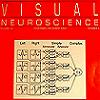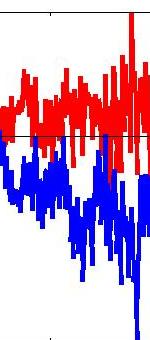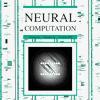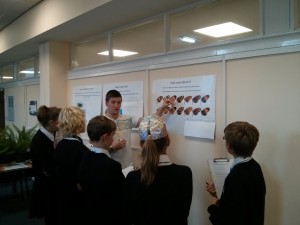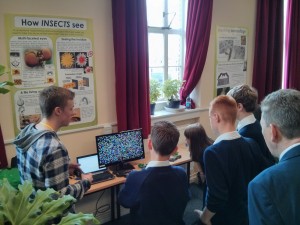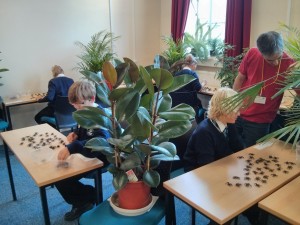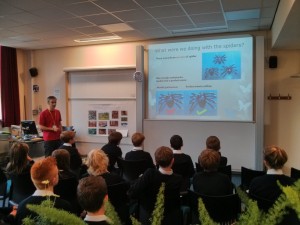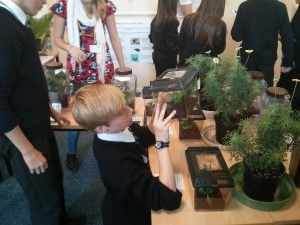I was pleased David Hubel was honoured by an obituary in The Telegraph, but I was surprised by the opening sentence: “When Hubel and Wiesel began experiments on vision and the brain in the late 1950s, neuroscientists thought that images from the retina were transmitted to visual centres in the brain, and projected onto the cerebral cortex in the same way as a photograph on to film.” Surely this underestimates 1950s neuroscience??
Monthly Archives: September 2013
Camouflage and Mimicry Workshop
Camouflage and Mimicry Workshop
Our lab has taken part in organizing the Camouflage and Mimicry workshop at the British Science Festival 2013 in Newcastle. Lab members Lisa, Paul, Sid and I (although to a much lesser extent) have participated in setting up a number of activities to introduce visiting young students to some of the fascinating visual trickery that living organisms employ to survive.
The workshop activities included a range of captivating presentations, engaging posters, live insect displays, visual illusions and even an actual scientific experiment. Our lovely visitors showed great interest and demonstrated their breadth of knowledge by giving surprising good answers to some of the presenters’ questions.
Below are some photos from the event.
(Above) Paul and Sid showing students that “things are not always what they seem to be”. On both sides of the natural competition between prey and predators; butterflies pose as poisonous species to deter predators and predators use 3D vision to detect an otherwise invisible prey.
(Above) Corry Gellatly giving students a taste of real science by asking them to “predate” (pick) non-poisonous spiders. Students begin by picking random spiders but later realize that some visual clues can help them in their task. Corry reveals the secret at the end of the experiment and of course … hands the top scoring student a “predator of the day” prize!
The live insect display gathered a lot of attention; student were fascinated by stick insects, praying mantids, assassin bugs and hissing cockroachs!
We’re all looking forward to future public engagement events. We hope the workshop has introduced our work and some of the questions we’re attempting to answer to the highly inquisitive minds of the future!
New Stars for Old
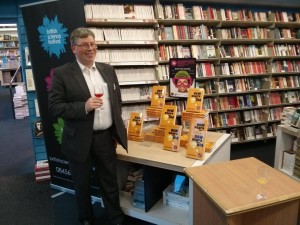 Anyone interested in the history of science in general and astronomy in particular can pick up a copy of my husband Marc’s book from the Newcastle branch of Blackwell’s on Percy Street. “New Stars for Old” is a series of linked short stories featuring characters from Aristotle to Newton, bringing to life the story of humanity’s attempt to understand the cosmos.
Anyone interested in the history of science in general and astronomy in particular can pick up a copy of my husband Marc’s book from the Newcastle branch of Blackwell’s on Percy Street. “New Stars for Old” is a series of linked short stories featuring characters from Aristotle to Newton, bringing to life the story of humanity’s attempt to understand the cosmos.
Welcome Vivek!
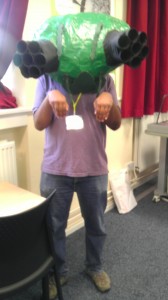
Delighted to say it was Vivek’s first day in the lab today. And he brought a delicious carrot cake along too! It was like the old days when Jennifer would bring along cake for lab meetings :).
Vivek wasted no time getting stuck in. He hasn’t even been given his computer log-in yet, but so far today he’s helped present a workshop on insects to local teens and worked with Ghaith on getting the mantids to strike at various visual stimuli. Oh, and he got transformed into a Kafkaesque man-insect hybrid. Not bad for one’s first day in a new job…
Day 2 of the British Science Festival
…and I am feeling I need a lie-down! All I did today was help present three 45-minute workshops to a total of nine groups of half a dozen kids. I realise this is nothing compared to the daily workload of a teacher, so all I can say to any teachers reading this is: Respect.
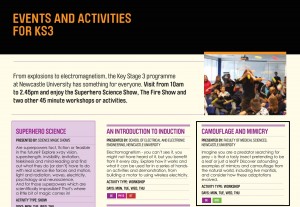
Today was the first day I had seen the workshop in operation, as I was tied up with a different event yesterday, and I was blown away by what a great event Lisa and Corry had organised (see inset image of the programme).
Everything ran very smoothly with expert presentation from Helen and Mandy, and the students (aged 11-14) seemed to really enjoy the different activities.
Corry had created an incredible giant sculpture of a praying mantis from translucent green acrylic. I don’t know what’s going on optically, but it really appears to glow with an inner light! Just incredible.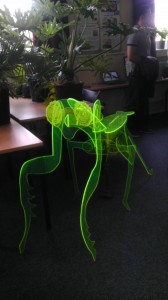
Lisa had made a papier-mache mantis head to demonstrate how insects see through compound eyes, which everyone enjoyed trying on.
We were all impressed by what a natural teacher Paul is: “Right! Front row is red group, you’re with Helen doing the experiment. Middle row, you’re blue group, you’re with me over here” – friendly but with a natural authority; great stuff.
Yesterday, I gave a short talk on 3D vision as part of a set of linked talks on perception (More than meets the eye, organised by Quoc Vuong and Debbie Riby). That seemed to go well, with engaged and perceptive questions from the audience. I also had a major grant submission deadline 30 minutes before my talk started, so that together with organising my contribution to the camouflage workshop made for a busy time. Thanks everyone for rallying round — I’ve been making a nuisance of myself texting various lab-members with pleas for help: “James can you go into town and get a 3D Blu-Ray”, “Paul can you pick up my poster on insect vision”, “Ghaith argh my camouflage-breaking stereo demo has broken, please fix it!” Thanks everyone for rallying round and keeping the various shows on the road.
British science festival, modelling and good time management
It is the British Science Festival (known from here as BSF) next week in Newcastle so the institute is very bustly over the last few days. Lisa on our team has done a tremendous job of organising not 1, not 2, but three timetables and stands for the BSF for our lab and affiliates to run. I’m heading up the poster and worksheet team, and hence working on it every day next week when it is on (mon – thurs). So if anybody does want to come and see the brilliance that is pure science and learn something new, come on down! I’ll be the guy with a big smile getting far too into the role.
In amongst that this week I have started the task of juggling my PhD. I say and really mean juggle, as even though I am only one month into a 36 month process I currently have two papers on the go, a mathematical modelling code to simplify, a student (Pramod) to keep an eye on for a long term piece, an online survey to collect data, a journal club to attend and various other equally important but not massively time consuming things to consider. Anybody who wants to get into science needs to have the focus and attention to concentrate on one problem for weeks on end, but also the ability to chop and change quickly between jobs and problems. How my supervisor Jenny copes is beyond me, as she (being the PI) is juggling the jugglers! that’s like juggling squared!
The modelling is taking up a lot of my time. The oblique angle study that I did for my MRES needs some statistical analysis before we can submit it to Journal of Vision, and that involves a lot of complex mathematical conversations with Jenny, something I properly enjoy! It does also require some serious matlab and more than a little bit of concentration. We have two normal (or Gaussian curves) centred around perpendicular viewing, and also on the angle for which the person is actually sat at, and we weigh the two curves accordingly, then optimise to fit the data. This is both very finicky (exact character matching and just missing a colon or a bracket brings everything falling apart) and time consuming. However it has been fun and the end is in sight. We have two options to pursue: an addition of the weighted curves or a multiplication. Looking at the fitted models in the graphs to me it appears that the addition route will give us a better fit. We then test this using bootstrap resampling (take all the data we collected, put it all together and mix it up, pick some data and random and go again) to determine how well the fit really is quantitatively.
Next week is all BSF, and hopefully a little bit of advancement on a paper on illusions I have written for the Leicester conference.








